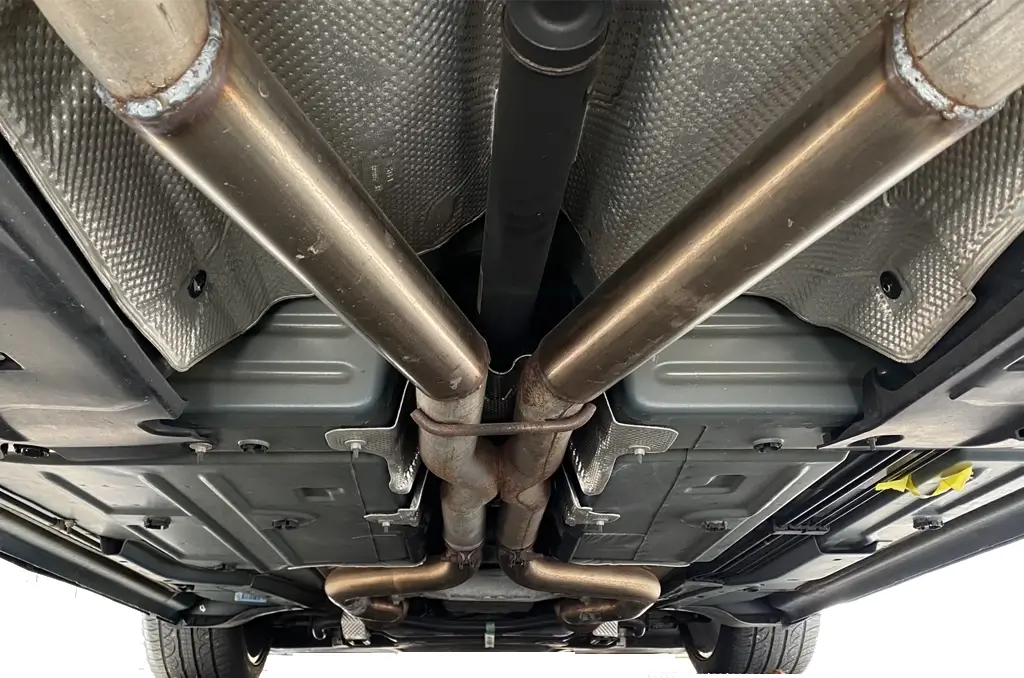Dodge Challenger & Charger Mid Muffler Delete Guide

If you’re a proud owner of a Dodge Challenger or Dodge Charger, chances are you’ve considered a mid muffler delete to unleash that aggressive exhaust tone these muscle cars were born to produce. This popular exhaust modification has gained major traction in the Mopar community, but is it the right move for your build?
In this guide we’ll cover all aspects of a mid muffler delete for your Dodge Charger or Challenger. Including performance, sound, legality, cost and comparisons to aftermarket mufflers.
What Is a Mid Muffler Delete?
What Does a Mid Muffler Delete Do on a Charger or Challenger?
A mid muffler delete removes or replaces the restrictive mid mufflers with straight pipes to improve exhaust flow and increase sound volume.
On Dodge Challengers and Chargers the mid mufflers are located under the center of the car, just after the X-pipe or H-pipe and before the rear resonators. These cylindrical components are easy to identify and are typically the first part of the system swapped out in exhaust mods.
They are not to be confused with the rear resonators, which sit closer to the rear bumper and are connected to the exhaust tips. These resonators are typically responsible for most of the sound suppression.
For the 5.7L HEMI, 6.4L Scat Pack and 6.2L Hellcat a mid muffler delete delivers:
Louder, deeper exhaust tone
Aggressive cold starts
More pronounced crackles and pops
Unlike a full muffler delete this mod keeps the rear resonators in place, maintaining some control over drone while still waking up the exhaust system.

Mid Muffler Delete Cost (Charger & Challenger)
The cost to perform a mid muffler delete on a Dodge Challenger or Charger varies depending on your approach:
Professional Shop:
Labor: $100–$200
Custom piping: $50–$200
Total: $150–$400
DIY:
Piping kits: $50–$200
Welding or clamp tools if needed
Total: $50–$200
Pro tip: Welded setups last longer, but bolt-on kits offer easy reversibility.
Mid Muffler Delete Performance & Sound
Does a Mid Muffler Delete Add HP to Dodge Charger or Challenger?
The short answer: Yes, but modestly.
A mid muffler delete can offer a slight performance gain of 5–10 horsepower, depending on the engine and setup. Gains are more noticeable in:
Scat Pack 392 and Hellcat models with freer-flowing factory systems
Vehicles with tuned ECUs or other bolt-on mods (e.g. cold air intake, headers)
However, the main benefit remains sound enhancement, not raw power.
Why Mandrel Bent Tubing Matters for a Mid Muffler Delete
When upgrading the midsection of your Dodge Challenger or Charger’s exhaust many enthusiasts opt for mandrel bent tubing. Mandrel bending is a process that forms smooth, consistent curves in the exhaust piping without crimping or reducing diameter at the bends.
This matters because:
Maintaining consistent diameter allows for better exhaust gas flow
Improved flow reduces backpressure, which can help optimize performance
It also helps produce a cleaner, more aggressive exhaust tone
Cheaper crush-bent pipes often used in budget exhaust shops, can create restrictions that cancel out the potential gains from a mid muffler delete. So if you’re investing in this mod, mandrel bent tubing is the smarter long-term choice. Especially for higher-output models like the Scat Pack or Hellcat.
For the best results ask your exhaust shop specifically for mandrel bent mid-pipes or choose a mid muffler delete kit that includes pre-bent mandrel sections.
Is It Noticeable on a Daily Driver?
Absolutely. Even on stock setups a mid muffler delete brings out the true tone of the HEMI engine.
Expect:
Louder startups and acceleration
More cabin vibration and possible drone at highway speeds
Deeper exhaust tone, especially under load
It’s especially noticeable on 5.7L V8s, which tend to sound more muted from the factory compared to 6.4L or 6.2L trims.
Will a Mid Muffler Delete Hurt My Engine or Warranty?
No, it won’t hurt your engine. The mid mufflers are part of the post-emission exhaust system, so removing them doesn’t impact the catalytic converters, oxygen sensors or engine internals. And when everything is properly installed you can keep your active exhaust valves.
However, keep in mind:
It may void your exhaust warranty, especially if your dealer considers it a non-OEM modification.
Check your local dealership policy, some Mopar techs overlook this mod, others don’t.
Always save your stock parts in case you don’t like the new sound or need to reinstall them for other reasons.
Legal Concerns for Mid Muffler Deletes
Is a Mid Muffler Delete Legal on a Dodge Challenger or Charger?
Legality varies by state and municipality. While the mod doesn’t alter emissions equipment, it can make your car exceed local noise regulations.
Some states where mid muffler deletes are often cited or fined:
California
New York
Virginia
States with more lenient exhaust laws (like Texas or Florida) may allow the mod if it doesn’t create a public nuisance.
Tip: If you’re worried about legality, check with a local inspection station or DMV website for noise regulation thresholds.

Mid Muffler Delete Pros and Cons
Pros
Budget-friendly sound upgrade
Unleashes true HEMI exhaust tone
Easy to install and reverse
Cons
Possible drone at highway speeds
May violate local noise laws
Could affect dealer warranty service
No massive HP gain—sound is the real benefit
Might require reinstallation for resale or inspection
No emissions impact
Lightweight compared to aftermarket exhausts
Final Thoughts — Is a Mid Muffler Delete Worth It for Your Dodge?
A mid muffler delete is one of the most popular modifications for Dodge Challenger and Charger owners and for good reason. It’s affordable, delivers a major sound upgrade and can even give your HEMI a slight performance edge.
If you’re looking to enhance your muscle car’s auditory impact without breaking the bank this is a mod worth considering. Just be sure to check local noise laws, understand the potential for drone, and always keep your stock parts if you ever want to reverse the install.




One thought on “Dodge Challenger & Charger Mid Muffler Delete Guide”